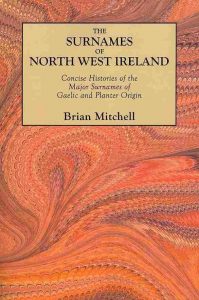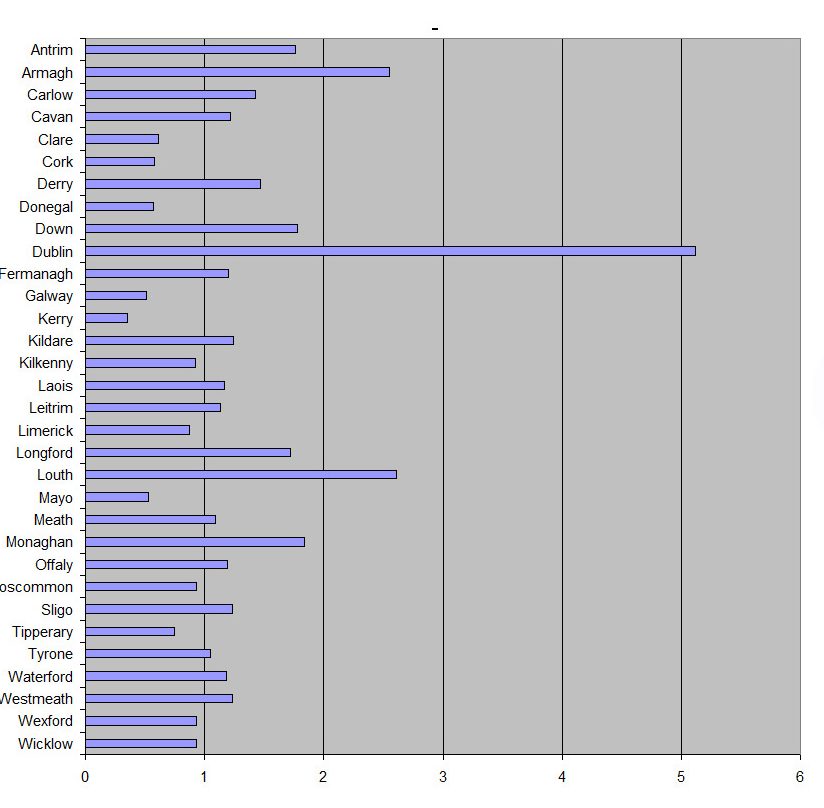Over the years, Irish surnames have received a good deal of careful attention, from Fr Patrick Woulfe’s Sloinnte Gaedheal is Gall (1923) to Edward MacLysaght’s Surnames of Ireland (1969) and most recently Seán de Bhulbh’s Sloinnte na hÉireann: Irish Surnames (1997). Ulster names have  been particularly well served. Robert Bell’s Book of Ulster Surnames (1997) and Brian Mitchell’s The Surnames of North West Ireland (2010) both dig deeper than an all-Ireland approach allows.
been particularly well served. Robert Bell’s Book of Ulster Surnames (1997) and Brian Mitchell’s The Surnames of North West Ireland (2010) both dig deeper than an all-Ireland approach allows.
All of them work to a similar format: summarise received wisdom about surname etymology and meaning; give rough geographic distributions; list well-known bearers of the name. They are essentially dictionaries focused on elucidating the surnames themselves, which makes them mainly of interest to bearers of the surnames and to local historians.
I’ve produced plenty of similar potted histories myself, and found it very hard. So hard that at one point in the early 90s I ended up inventing a ‘well-known’ bearer of a surname, complete with fictional back-story. And then forgot which surname it was. So somewhere, I think on this site, is a non-existent famous person. I believe (though I can’t be sure) that I was channelling The Scarlet Pimpernel.
More seriously, the study of surnames, in particular surname distributions, can provide decent historical evidence, especially now that technology allows historic data to be mined and examined in novel ways. One example is mapping surname variety across Ireland in the mid-19th-century Griffith’s Valuation census substitute. Simply take the number of distinct surnames listed as householders in each county and divide by the area of the county. The result is an average number of different surnames per area.

Unsurprisingly, Dublin has the densest concentration of names, but the area with by far the next greatest variety is the ancient tuatha of Oriel, comprising Armagh, Louth and Monaghan. The western seaboard counties (with the exception of Sligo) have surname densities far below average, even though they were the most highly populated areas. The northeastern counties, with their mix of Scots-Irish and Gaelic-Irish, have surname variety well above average. The clear conclusion is that surname variety or density is a respectable proxy for cultural diversity. Or cultural purity.
Plenty of onomastics like this can be found at the Society for Name Studies in Britain and Ireland, snsbi.org.uk.
When attempting this sort of survey, how do you allow for the erratic spelling of the same surname in Griffith’s Valuation?
It seems to me that many of the surveyors, when an occupier was illiterate (or the surveyor assumed he was) recorded the surname as they thought it was/should be spelled. This becomes very obvious when you compare different records for the same family. Within the county returns in Griffith I have seen what appear to me to be obvious patterns showing the spelling preferences of different surveyors. You see the same picture in parish registers.
I just wonder how do you make allowances for this when trying to do an analysis of surname distribution?
Always wondering if surname research when say top 20 surnames are removed is incredibly difficult. My surname is Monks and why it was almost concentrated 100% in Dublin on the 1901 and 1911 Censuses is a puzzle to me. Of course there are many surnames like Monks not great in number that are concentrated in certain areas but find that Monks at c500 is a bit high and would lead to an interesting explanation if I knew how to do the research.
John Gresham’s table of density of names related to area of county is interesting. In the 1990’s I worked with telephone directories for my book of surname distribution maps. Much the same picture emerges. I found:
“What seems to be an overall pattern is that the south has fewer names but averages a greater number of people per name. It is strong on names from the heroic era, when virtues such as those in the meanings of Kelly or Murphy were the admired qualities. The northern half of the country has these names too, but examples there do not have the numerical strength of the south. As one moves north, surnames become more numerous and have a greater range of type of origin, even excluding names brought from Scotland and England. The north has surnames based on trades, and on saints’ names or on religion in other forms. No doubt the same trades were carried on in the south, but for the religious origin names, it does not matter where the saint lived. For example, the cult of St. Brigid was centred on mid-Leinster, but the surname McBride, in full Mac Gil Bride, is concentrated in the north. Saints’ names may be prefixed by ‘Mul’, devotee of, or ‘Gil’, servant of. In some forms, the prefixes may have been dropped.” I worked with only 200 names for what became my ebook – more if presence or absence of prefix are counted separately. Decisions had to be made whether to put one or more distributions on the same map.
Fiona Duignan’s point on spelling is valid and not just for the era of Griffith Valuation. My grandfather died in the 1930s. Cradle to grave, his surname was recorded five times, each with a different spelling, one of them with an initial ‘K’. The family left behind in Ireland have settled for ‘Kneafsey’, not one of my grandfather’s five. On my own marriage certificate, England, 1967, there are two ‘boxes’ for bridegroom’s surname, not entered by bridegroom himself. In one appears as ‘Neafcy’ and the other ‘Neafsey’. I never corrected it – or I should say – tried to make it consistent. How would one do that and why bother?
Hi Edward. Your book was the spur for my own digital maps. I’m afraid on the variants, for this chart at least, I just stuck with literals. “McIlhatton”, McElhatton” and “McElhattan” are counted as different, so spelling variation introduces noise into the statistical signal. See https://www.johngrenham.com/browse/retrieve_text.php?text_contentid=460#surnamedata for caveats.
John
And it’s Grenham, not Gresham
Any help in getting info on the Loughrey/Loughry/Loughery surname (my great-great-grandfather was Patrick Loughry (~1800 presumably Tyrone — 1886 Quebec) would be appreciated. I gather that many Loughrey lived between Coleraine and Lough Swilly in the mid 19th century. Were they originally Protestants or Catholics? The name is not easy because 1) of the many variant spellings—about 18 different ones in America and 2) there is the issue of confusion between three different family names: Loughrey, Loughran and Lowry.
I’m a Loughrey born in Co Kildare Ireland. Upon tracing I eventually found my great grandfather’s marriage and the birth of my grandfather registered as Locherty in Dundee Scotland in the 1870’s. My great grandfather is shown in the 1901 census as born in Westmeath Ireland, upon return from Scotland my Loughrey’s ? We’re sometimes registered as Lougherty sometimes Loughery and sometimes Loughrey. The T in the name initially made the chase difficult as I was not expecting it.
I would love to find where in Ireland my second great grandparents lived, worked, and went to church.
The surnames are Kirby and Stokes (Limerick or Mayo), and Carroll and Kearns- no idea at all.
One thing has perplexed me is how even folks whp knew my fmaily spelled it in different ways: Crane, Crean and Creane. I assume, perhaps wrongly, that the parish priest or his clerk, knew our family, yet they consistently spelled it three different ways. This was a time (1810-1840) when surnames were still not standardized. But, sitll, couldn’t you guys have asked us? …. Sigh.
My grandfater came from Kildare i know that much 1869 yr of birth 1960 yr of death but his family are a mystery his name was Laurence Patrick Fox this surname has proved hard for me to find his relatives . Is this an Irish name can any one help……….
mary josephine Fox his grandaughter.
I know this post is 3 yrs old but, if you have 3 girls with first name initials D, C & L please contact me on Facebook.
Debbie
(Roy’s 2nd x wife)
I am stuck on Everard. Though believed to be from Meath and Tipperary, two generations were baptized in Dublin. James in 1746 and his sons Denis in 1778 and Patrick in 1781. Denis eventually emigrated to Newfoundland Canada. I have never found a record of Patrick other than his baptism. I am descended from Richard, another brother of Denis ( or perhaps he and Patrick are one and the same!) I do have evidence of Richard in Newfoundland as witness to some marriages beginning in 1803 and his own marriage in 1807, as well as all the baptisms of his five children.
We would all spell them correctly if we were Gaeilgeoiri. We eff up because we presume any form in English of a Gaelic surname is correct …
I am seeking info about the “O’Bannon” clan and the Bannan name in Ireland c 15th century.
Leith Castle in Kings County was built by the O’Bannon clan in the 13 or 14th Century and was later taken over by the O’Carroll Clan but I have not been able to discover any data to support these theories.
If you could advise where to look I would much appreciate
Regards from Victoria, Australia
Stan Bannan
0438262091